No Picture the Same: Graphic Novel Reviews
If you go to a bookstore, every shelf is filled with words upon words upon words. There is a corner or a section dedicated to the special books that include pictures as well: graphic novels. But those books are so diverse, so varied, it’s a wonder they aren’t spread all over the store, in every genre. Read one of these six reviewed in our May/June 2017 issue.
Last Things
A Graphic Memoir of Loss and Love
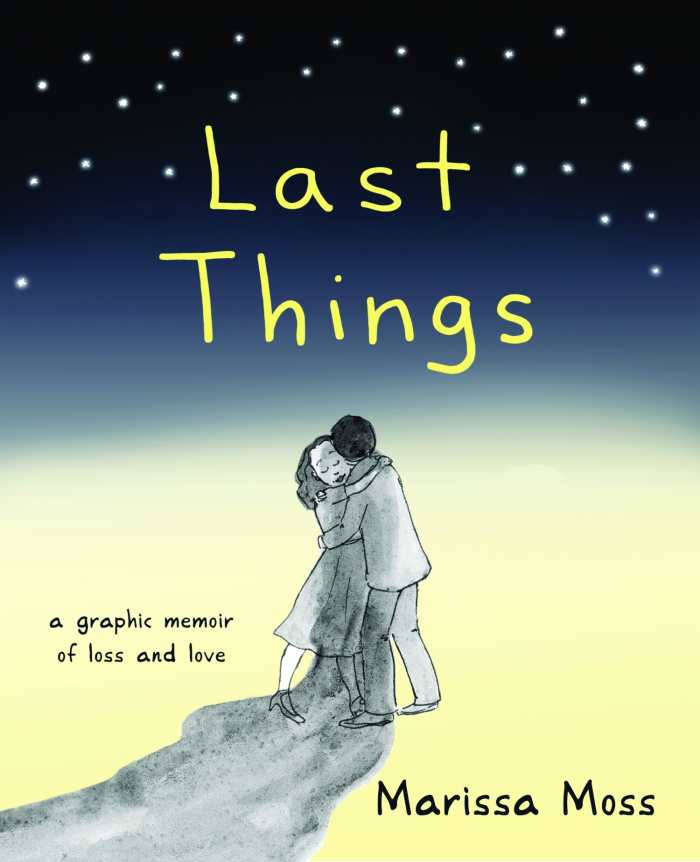
Marissa Moss
Conari Press
Softcover $18.95 (184pp)
978-1-57324-698-9
Buy: Local Bookstore (Bookshop), Amazon
Marissa Moss shares the brutal experience of her husband’s deterioration from ALS, in her unflinching graphic memoir, Last Things.
Moss, a successful author of many children’s books, including the Amelia’s Notebook and Young American Voices series, finds a subject closer to home in Last Things—her husband Harvey’s diagnosis and eventual death of Amyotrophic Lateral Sclerosis (ALS), also known as Lou Gehrig’s disease. After symptoms emerge during an overseas trip, Harvey Stahl, a distinguished professor of medieval art at the University of California, Berkeley, quickly declines, slurring words and having trouble walking. Moss relates the story through her eyes, but also through Harvey’s and their children’s when possible, giving a complete view of the tragedy from all sides.
Harvey alternates between active denial of the seriousness of his condition, and withdrawal from the family as he attempts to finish a book. Moss juggles parenting her three children and taking care of Harvey. The stress and emotional tension is palpable throughout the book, a testament to Moss’s honesty; she openly reveals her resentment at the obstacles to her own writing, or Harvey’s lack of involvement with the kids. It’s these very human reactions that make it all the more affecting when she steps back from the heavy household demands to reflect on her relationship with her husband:
“We remember ‘firsts,’ are aware of them by their very nature. But last things sneak up on you, slip away, unnoticed … Harvey and I share a lot of ‘lasts’ and we don’t even know it.”
Moss’s black-and-white illustrations are simple but expressive, perfect for telling this story. Last Things is difficult to read at times, grueling in its emotional detail, but ultimately it stands as a moving memoir and a guide not just for those caring for someone afflicted with ALS, but anyone seeking a better understanding of the processes of dying or grieving.
PETER DABBENE (May 9, 2017)
Brik
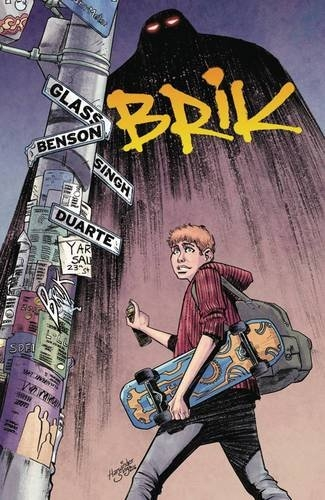
Adam Glass
Michael Benson
Harwinder Singh, illustrator
Oni Press
Softcover $19.99 (144pp)
978-1-62010-392-0
Buy: Local Bookstore (Bookshop), Amazon
The legend of the Golem is brought to modern-day Yonkers, New York, in the graphic novel Brik, by Adam Glass, Michael Benson, and Harwinder Singh.
After twelve-year-old Drew loses his grandfather to gang violence, he successfully invokes the Jewish Golem myth to seek protection—and revenge. Addressing the Golem, Drew tells the creature, “We need to make our mark./ Something to let people know…/ that we are here./ And that there is hope. From here out yer name is Brik.”
The tale unfolds convincingly, with believable motivations and problems as Drew tries to safeguard his mother and the small store they’re being harassed to sell.
There are two major “twists,” one of which, delivered on the final page, succeeds better than the other. But Glass and Benson, with plenty of experience writing both comics and television, create a convincing self-contained community, populated by local thugs, heroes, and average citizens. The somewhat familiar character archetypes, including the stubborn old grandfather and worried mother, become appealing people in their own right, not just devices to move the plot along.
The urban environment is rendered in a vibrant, kinetic style by Singh (and colorist Gonzalo Duarte), bringing the common adolescent power fantasy of being a hero (or, in this case, controlling one) vividly to life. Though it’s entertaining fiction, Brik goes deeper than a typical “kid rights wrongs” story; it teaches universal lessons on the costs of vengeance, and the dangers of purely emotional responses to one’s problems. Due to violence and language, its intended audience is those age thirteen and up, but for those above that cutoff—by days or by decades—Brik makes for an engrossing and thought-provoking tale.
PETER DABBENE (May 9, 2017)
Love, Retold
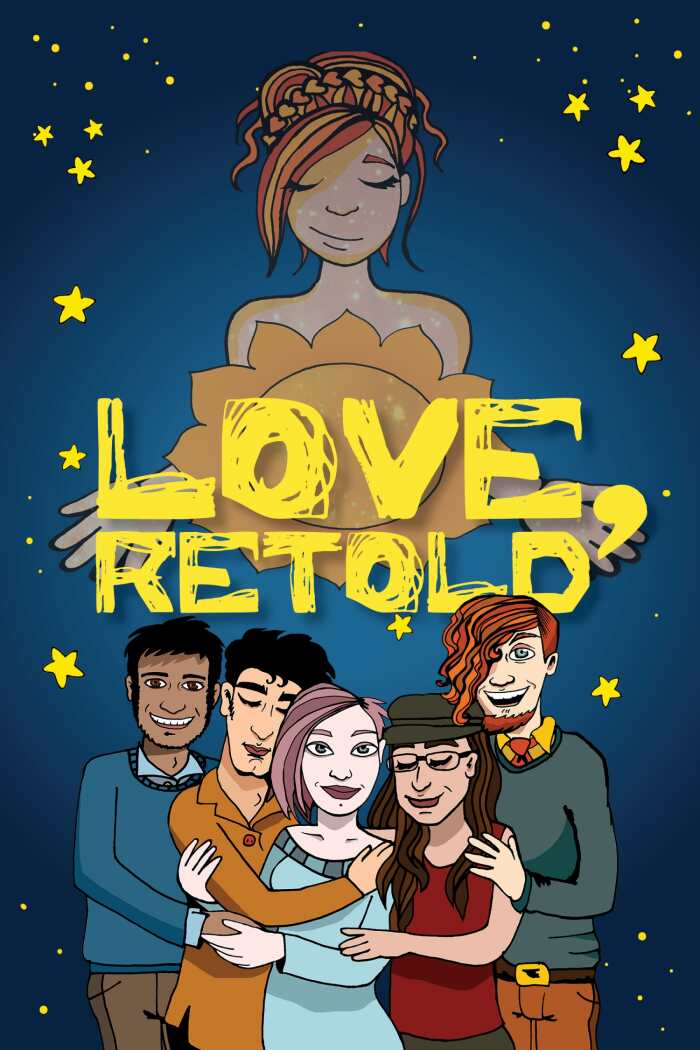
Tikva Wolf
Thorntree Press
Softcover $17.95 (96pp)
978-1-944934-17-0
Buy: Amazon
There’s been much discussion in recent years about different sexual identities, a once-controversial topic, but it’s safe to say that polyamory (romantic relationships with more than one partner) is less understood, and less widely accepted. Tikva Wolf shares her experiences of love, in all its forms, in her graphic novel Love, Retold.
Told in an intimate narrative style, Wolf uses lots of first- and second-person pronouns: “You grew a beard while I grew a baby.” The relationships depicted aren’t fully described right away; rather, they’re revealed through the respective chapters, in text and image. While at times it feels like the narrative is more like a diary, not meant for a wider audience, Wolf’s honesty of emotion, freely expressed, makes up for any momentary confusion.
She touches on dissenting views, like when she quotes her husband saying “Polyamory? I’m not really into that.” Later, he seems to accept the idea, but it would have been interesting to hear more from him and the other parties featured in the book.
While Wolf shows and describes her relationships with several romantic partners, she also highlights platonic love with points of insight, such as this one about a longtime friend:
People talk about ‘soulmates’ and ‘life partners,’ reserving these special titles for romantic partnerships alone, but I feel more deeply sure about her remaining in my life than any romantic partner I’ve ever had.
Wolf’s color artwork is raw and cartoony, but more than adequate to tell her tale. Love, Retold is an apt title—Wolf’s book doesn’t necessarily aim to redraw the lines of a largely monogamous society; instead, by relating her personal experiences, she looks to encourage individuals to simply find what works best for them and embrace it.
PETER DABBENE (May 9, 2017)
The Adventures of Kung Fu Robot
How to Make a Peanut Butter, Jelly, and Kung Fu Sandwich
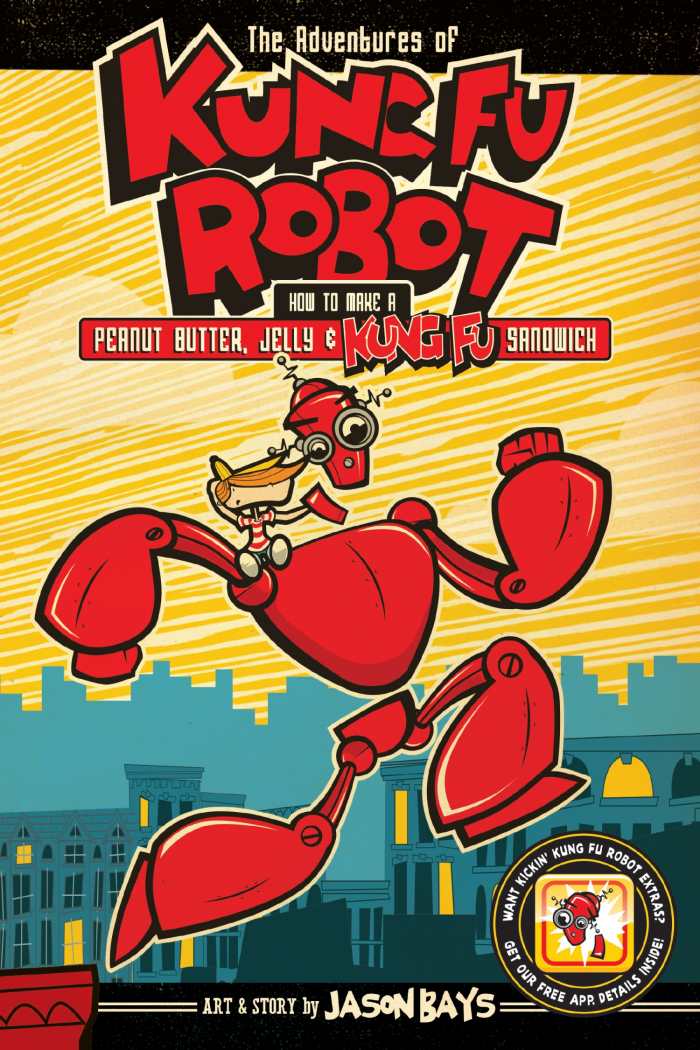
Jason Bays
Andrews McMeel Publishing
Softcover $9.99 (208pp)
978-1-4494-7963-3
Buy: Local Bookstore (Bookshop), Amazon
A robot who knows Kung Fu and loves peanut butter and jelly sandwiches battles a chicken who aims to, of course, steal all the peanut butter and jelly he can find, in The Adventures of Kung Fu Robot: How to Make a Peanut Butter, Jelly & Kung Fu Sandwich, by Jason Bays.
If that sounds a bit wacky, it is—Kung Fu Robot began as an app that’s now been downloaded over half a million times, with games like “Whack-A-Ninja” and “Unicycle Race.” The games aren’t particularly original in their basic execution, but they’re done with great style, outstanding art, and an offbeat sense of humor, and the same can be said about the story told in the graphic novel.
Kung Fu Robot and his best friend and sidekick, a nine-year-old boy named Marvin, battle against a horde of ninjas and their commander, the evil Kung Pow Chicken, who is behind a series of peanut butter and jelly thefts. The book is heavy on action, which keeps things simple and fast-moving, and also gives the opportunity to show off some augmented reality features. By downloading the free app and using the “Kung Fu Vision” feature, special add-ons, sound effects, and games can be unlocked by scanning the appropriate page in the book.
The dialogue is fast-paced too, with ongoing commentary by Kung Fu Robot, including amusing little asides like “That worked out differently in my head.” Why does a robot need to eat anything, let alone PB&J sandwiches? It’s not important, because the primary goal of The Adventures of Kung Fu Robot is easily forgettable fun, which it delivers, in loads—the perfect recipe for the eight- to twelve-year-old intended audience.
PETER DABBENE (May 9, 2017)
Audubon
On The Wings Of The World

Fabien Grolleau
Jérémie Royer, illustrator
Etienne Gilfillan, translator
Nobrow
Hardcover $22.95 (184pp)
978-1-910620-15-1
Buy: Local Bookstore (Bookshop), Amazon
The name Audubon is synonymous with ornithology, but it’s the man behind the famous wildlife paintings that’s revealed in Fabien Grolleau and Jérémie Royer’s beautiful graphic novel, Audubon: On the Wings of the World.
The environmentalism of Audubon’s era seems paradoxical by today’s standards; like Theodore Roosevelt after him, he shot and killed many creatures while attempting to draw attention to their beauty and emphasize the importance of conservation. This is shown subtly but effectively in Audubon, when he’s depicted shooting down a nesting pair of ivory-billed woodpeckers (a species now critically endangered) and culling from a huge flock of passenger pigeons (a species now extinct). But the book quietly makes the case in defense of Audubon—his was a different era with different standards, to be sure, but moreover, his paintings really did help to impart an appreciation for wildlife in America, particularly with regard to birds.
Royer’s art and composition are superb, and it’s obvious that he, too, spent a lot of time looking at birds in order to produce his own striking illustrations. Royer’s most engaging drawings, though, are Audubon’s surreal dream sequences, incredible compositions that give more insight into the man than all the adventures retold in the book.
Grolleau, meanwhile, has created a masterful blend of Audubon’s own writings and uses a bit of creative license (all explained in the notes at the end of the book). These imaginative assists to the narrative, such as a meeting and conversation between Audubon and Charles Darwin, may not be to the taste of sticklers for fact, but Audubon: On The Wings of the World is more than mere biography: it’s a book that leaves a lasting impression, in words and especially images, of a man whose legacy survives to this day.
PETER DABBENE (May 9, 2017)
Instrumental
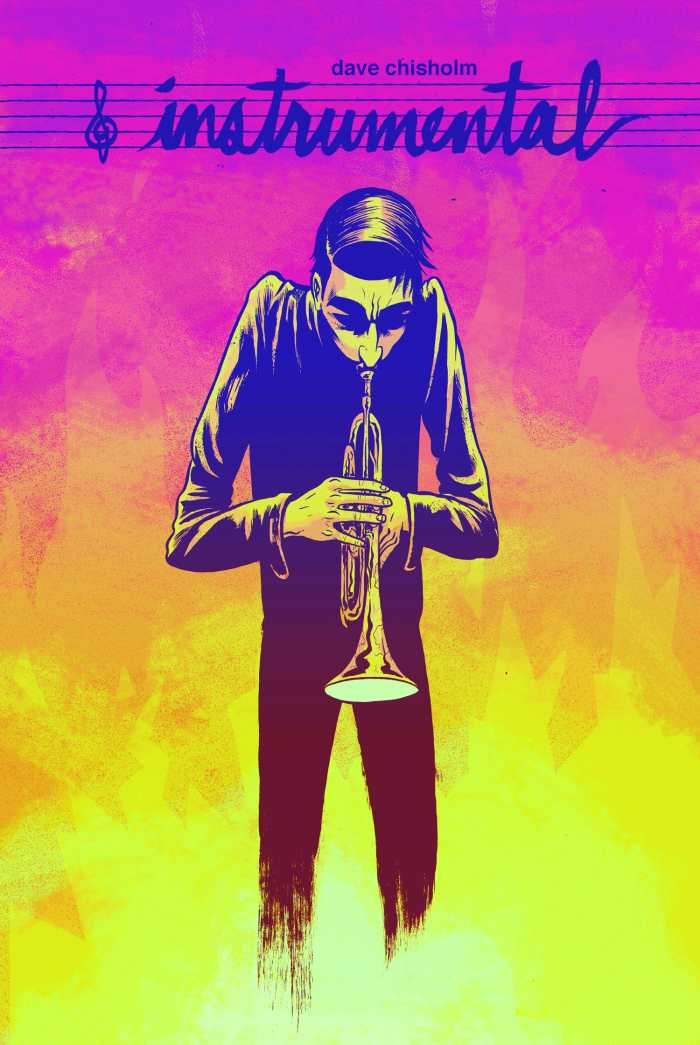
Dave Chisholm
Z2 Comics
Softcover $24.99 (224pp)
978-1-940878-15-7
Buy: Amazon
It’s not often that one sees successful cross-pollination between the worlds of comics and music, but Dave Chisholm accomplishes just that with his graphic novel (and accompanying soundtrack) Instrumental.
Chisholm is an accomplished jazz trumpeter, and he draws on personal experience to create a convincing world for his central character, a talented but frustrated trumpet player named Tom Snyder. Snyder is tired of playing to small audiences, so when a mysterious stranger gives him an old trumpet that captivates listeners and poises Snyder for next-level success, he doesn’t question his good fortune. But others are in pursuit of the trumpet, and Tom’s friends notice a change in him. The trumpet is revealed to have a destructive provenance, and Tom is forced to question what art means to him, and the role and importance of commercial success.
The personalities of Tom and his friends are unique and appealing, from the old-time bassist who played four dates with Ornette Coleman and distrusts music schools and the Internet, to the young drummer who defends her college major in jazz drumming, to the piano player/florist who compares creating a flower arrangement to putting together a perfect four-piece rock band.
It’s appropriate that Instrumental is a multimedia experience, as the questions it raises are universal to any form of art: as Tom’s pianist points out to him, “If all you love is the result or even whatever reward the result gets you—/—it’s just chasing your tail. You’ll never be satisfied.”
The black-and-white artwork in *Instrumental *is dynamic and inventive, perfectly illustrating both the transcendence of music, and Tom’s struggle as he falls under the influence of the trumpet and everything it represents. Instrumental is recommended for any reader, but perhaps most for those who have a love for music. (Note: each copy of the book will have a QR code linking to a free download of the soundtrack.)
PETER DABBENE (May 9, 2017)
Peter Dabbene

